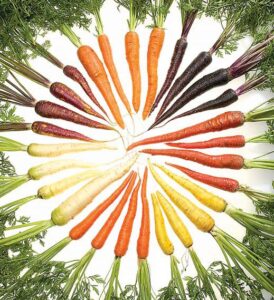
Beets, carrots, and radishes are easy roots for children to grow.
As gardeners continue to harvest crops of cucumber, eggplant, bush and pole beans, okra, peppers, tomatoes, and yellow and zucchini squash in late summer, it’s time to plan and plant the fall food garden. This year try two cool season gardens—the above ground produce like arugula, broccoli, cauliflower, cabbage, collards, kale, lettuces, mache, tat soi, pak choy, spinach, and Swiss chard—and the underground garden.
The underground garden includes a wide variety of root vegetables tolerant of and even preferring cooler and cold weather. Beets (Beta vulgaris) come in white, yellow, and red globes and with green tops used in salads or as a cooked vegetable.
Carrots (Daucus carota) come in a rainbow of colors and all shapes and sizes. From traditional long, tapered ones, short and stubby, tiny fingerlings, and even small round Parisienne carrots popular in France. Celeriac (Apium graveolens var. rapaceum) aka celery root or celery knots is a bulbous celery vegetable that tastes similar to celery but with a dense, crisp, fibrous texture. Celeriac is used in salads, braised and served with a cream sauce, or mixed with pureed potatoes.

Garlic (Allium sativum) is an onion grown from cloves that can be purchased in heads from nurseries, mail-order catalogs, and the grocery store. Garlic dislikes hot weather and overwatering.
Radish (Raphanus sativus) seeds are quick to sprout and one of the easiest and fun vegetables for children to grow. Fall is the best time to sow and grow the two groups of radishes— short season and long season. Short season can grow as fast as three weeks from seed to table. Short season radishes can be grown in succession throughout fall and winter. Long season radishes, aka daikon, Oriental or winter radishes can take from 60 to 90 days to mature.
Rutabagas (Brassica napus) are a cool weather crop that takes three months to mature. Frost improves the flavor. Plant seeds between August 15 and October 15 for winter harvest.

Rainbow colored carrots This work has been released into the public domain by its author, Stephen Ausmus, U.S. Department of Agriculture. This applies worldwide. Stephen Ausmus, U.S. Department of Agriculture, grants anyone the right to use this work for any purpose, without any conditions, unless such conditions are required by law.
Turnips (Brassica rapa) germinate in five to ten days in late summer. Turnips may be grown for the greens on top as well as for the roots. Plant seeds now for greens by Thanksgiving. The turnip root takes one to two months to mature.
Soil texture is important for all root crops. Make sure the soil is loose, welldrained, and well ventilated by incorporating plenty of organic matter like homemade compost, well rotted manure, or bagged humus. Is the soil pH correct for each of the root crops? You may need to add phosphorus for root development.
Include children when planting of the underground garden. They will enjoy growing the underground garden in a pillow pack, a plastic bag of premixed soil like Daddy Pete’s, ReSoil Compost, or Stout Ollie Compost or in a felt Smart Pot. These bags or pots can be used for short root crops like beets, carrots, garlic, and radishes.


Comments are closed.